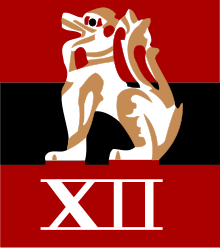Twelfth Army (United Kingdom)
| Twelfth Army | |
|---|---|
 12th Army formation badge. | |
| Active | May — November 1945 |
| Country | |
| Branch | |
| Type | Army |
| Size | Field army |
| Engagements | Battle of the Sittang Bend |
The Twelfth Army was a British Army formation during the Second World War. The Twelfth Army denotation was actually used twice; firstly, in 1943, for a fictional formation and secondly, in 1944/45, in Burma.
The Twelfth Army moniker was originally used by Advanced Headquarters 'A' Force, a Cairo-based deception department created by Dudley Clarke, for a formation used in Operation Barclay and Operation Zeppelin. It was later used for a real formation in Burma, which took over operations from the Fourteenth Army and would later become Burma Command.
1943: Middle East
A British Twelfth Army was initially invented by 'A' Force as part as the deception plan for Operation Husky, the Allied invasion of Sicily in July 1943. The Western Allies attempted to convince the Germans that their main effort during 1943 would be to land the Twelfth Army in Greece and then advance into the eastern Balkans during the early part of the summer of 1943 with the aim of bringing Turkey into the war and then linking up with the Soviet Red Army.[1] The deception plan attempted to convince the Germans that this army had twelve divisions under its control and was located in Egypt.[1][2] The army's formation insignia was a trained seal balancing on its nose a terrestrial globe showing the Eastern Hemisphere, black on a white background.[3] The insignia was supposed to symbolize an amphibious creature treating the whole world as its own.[4]
Subordinate units
Between 1943 and 1945, when it was disbanded to allow the formation of the second British Twelfth Army, its nominal existence was used to create the impression of a standing threat to the Balkans. During this period the units shown under its control varied, depending on the target chosen. The following list includes all units mentioned as forming part of the Twelfth Army or its component corps.[4][5]
Corps
 British III Corps (fictional)
British III Corps (fictional) British XIV Corps (fictional)
British XIV Corps (fictional)- British XVI Corps (fictional)
- Polish III Corps (fictional)
Divisions
- Polish 2nd Armored Division
 British 4th Airborne Division (fictional)
British 4th Airborne Division (fictional) British 5th Airborne Division (fictional)
British 5th Airborne Division (fictional) British 5th Infantry Division
British 5th Infantry Division- Polish 7th Infantry Division
 British 8th Armored Division (fictional)
British 8th Armored Division (fictional)- Polish 8th Infantry Division (fictional)
 British 15th Motorized Division (fictional)
British 15th Motorized Division (fictional) British 33rd Infantry Division (fictional)
British 33rd Infantry Division (fictional) British 34th Infantry Division (fictional)
British 34th Infantry Division (fictional) British 40th Infantry Division (fictional)
British 40th Infantry Division (fictional) British 42nd Infantry Division (fictional)
British 42nd Infantry Division (fictional) British 56th Infantry Division
British 56th Infantry Division British 57th Infantry Division (fictional)
British 57th Infantry Division (fictional)
1945: Burma

The second British Twelfth Army was formed on 28 May 1945,[6] to take control of operations in Burma from the Fourteenth Army, which was being withdrawn to plan for Operation Zipper, the planned invasion of Malaya by amphibious assault, which was due to take place in August 1945.[7] The army HQ was created by re-designating the HQ of the Indian XXXIII Corps, under Lieutenant-General Sir Montagu Stopford.[8]

After the war, Twelfth Army continued in existence until 1 October, when it was re designated Burma Command. The formation insignia was a Chinthe on a red background, with a superimposed horizontal black stripe on which was written "XII" in white letters.[9]
Notes
- ^ a b (Howard 1995, p. 86)
- ^ (Bacon 1998, p. 3)
- ^ "badge, formation, British, 12th Army". www.iwm.org.uk. Retrieved 12 August 2023.
- ^ a b (Holt 2005, p. 913)
- ^ (MacIntyre 2010, p. 120)
- ^ "New Burma Army, 1945-1949". www.rothwell.force9.co.uk. Retrieved 2023-05-01.
- ^ "Obituary:Tun Ibrahim Ismail". The Daily Telegraph. 26 January 2011. Retrieved 30 January 2011.
- ^ "Stopford, Montagu George North". Generals.dk. Retrieved 22 March 2024.
- ^ "Badge, formation, 12th Army". Imperial War Museum. Retrieved 28 May 2020.
References
- Bacon, Maj. Donald J. (1998). Second World War Deception: Lessons Learned for Today's Joint Planner (PDF). Air University Press. Archived from the original (PDF) on December 3, 2003.
- Holt, Thaddeus (2005). The Deceivers: Allied Military Deception in the Second World War. Phoenix. ISBN 0-75381-917-1.
- Howard, Michael (1995). Strategic Deception in the Second World War. British Intelligence in the Second World War. New York: Norton. ISBN 0-393-31293-3.
- MacIntyre, Ben (2010). Operation Mincemeat. Bloomsbury. ISBN 978-1-4088-0921-1.
